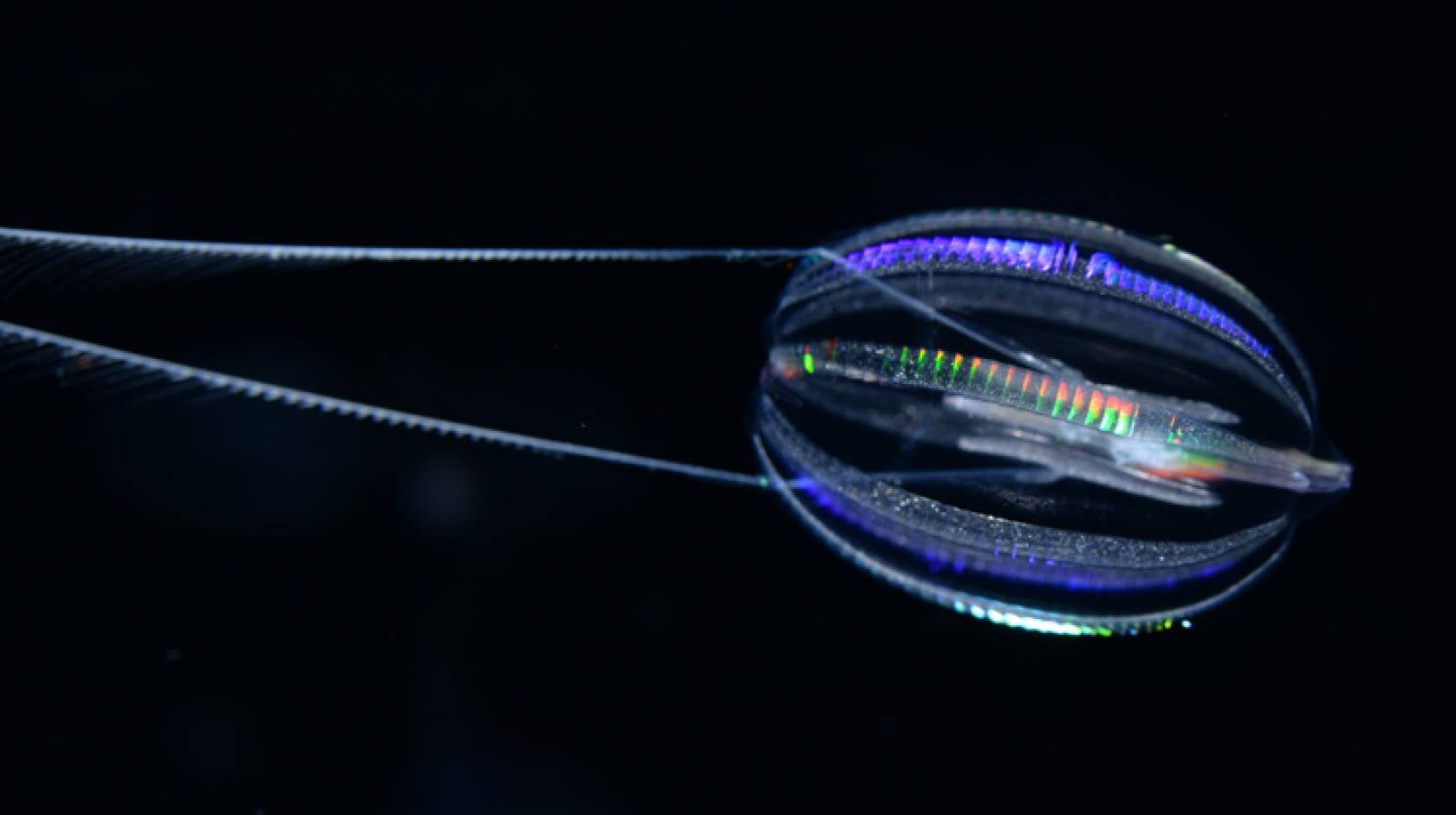Emily Cerf (UC Santa Cruz) and Raúl Nava (MBARI), UC Santa Cruz

All animals are related to each other, but comb jellies — a marine invertebrate found in oceans around the world — are the most distantly related to all other animals, shows a new study in Nature. This means that comb jellies were the earliest lineage to branch off the tree of life, and all other animals evolved separately, after comb jellies diverged.
This research, published by a team of scientists including two UC Santa Cruz professors and a former UC Santa Cruz grad student, resolves a centuries-old mystery about the pivotal moment when an ancient organism gave rise to the diverse array of animals in the world today.
Scientists have long investigated two alternative hypotheses for which animals — sponges or comb jellies, also known as ctenophores — were most distantly related to all other animals. The team found strong evidence that comb jellies are a unique lineage or “sibling group” whose ancestors diverged before the common ancestor of all other animals. This finding can give fresh insight into how key features of animal anatomy, such as the nervous system or digestive tract, have evolved over time.
“We developed a new way to take one of the deepest glimpses possible into the origins of animal life. We’ve used genetics to travel back in time about one billion years to get the strongest evidence yet to answer a fundamental question about the earliest events in animal evolution,” said Darrin Schultz, first author on the paper and who led the research as a UC Santa Cruz graduate student. “This finding will lay the foundation for the scientific community to begin to develop a better understanding of how animals — and humans — have evolved.”
In the new study, a team of researchers from UC Santa Cruz, the Monterey Bay Aquarium Research Institute (MBARI), UC Berkeley, and the University of Vienna used new techniques to compare the genomes of comb jellies and sponges to find evidence about one of the earliest moments in animal evolution.
Researchers at MBARI, including Steve Haddock, an affiliate faculty in UC Santa Cruz’s ocean sciences department, were able to collect DNA samples of these squishy sea creatures from the nearby Monterey Bay and sequence them. Richard (Ed) Green, UC Santa Cruz professor of biomolecular engineering, and his lab led the genome assembly efforts, creating a complete and accurate picture of the entire length of each chromosome for two comb jellies and two marine sponges, as well as three single-celled close relatives of animals in order to create a more complete and organized picture of each one’s genes.
With the complete sequences in hand, the researchers looked for patterns of linked genes to help answer the question of whether sponges or ctenophores are the most distant relative of all other animals.
While groups of animals have evolved hundreds of millions of years apart, a remarkably large number of genes remain located on the same chromosomes across these vastly different animal groups. Over time, the order of the genes may change, but they remain located on the same chromosome, except in rare circumstances.
In the past, researchers have compared the order of genes on a chromosome to infer how closely related groups of organisms are to one another, with more similarities indicating that groups are more closely related. However, they found that this technique did not give reliable answers when looking this far back in animals’ evolutionary history.
The complete genome sequences for the animals allowed the scientists to observe previously-unseen occurrences that happen at the chromosome level. Studying the evolutionary history of the chromosomes, which occurs on the time-scale of hundreds of millions of years, rather than just the genes within a chromosome, showed that chromosome evolution follows unique and unpredictable rules.
“When you look at the changes that happen in chromosome evolution, which happen much more slowly, it gives us hope that all of life’s history may be knowable, if we just look at the right thing in the right way,” Green said.
When they examined the chromosome-scale genome of comb jellies, they saw a grouping of genes that was very different from the patterns in other animals. Most importantly, they found patterns of genes that were shared between the comb jellies and three non-animals, whereas those patterns of genes have been shuffled and mixed in all other animals. This provided clear evidence that the comb jellies split off first, before all other animals.
“That was the smoking gun — we found a handful of rearrangements shared by sponges and
non-ctenophore animals,” said Daniel Rokhsar, a co-author on the study and a professor at UC Berkeley. “In contrast, ctenophores resembled the non-animals. The simplest explanation is that ctenophores branched off before the rearrangements occurred.”
Resolving this long-standing question will help shed light on how anatomical systems formed in the earliest animals and how they evolved into the advanced digestive tracts, muscles, and nervous systems in other animals. It can also help scientists better understand how single-cell organisms evolved into multicellular life.
“Getting this right lets us better understand how the very complex life that we have now came to be,” Green said. “It also lets us go backwards in time and understand how the transition from single-cell to multicellular life worked in better detail. This is one of the deepest mysteries that exists.”
Funding for this research was provided by the David and Lucile Packard Foundation, MBARI, the National Science Foundation (GRFP DGE 1339067 and DEB-1542679), the European Research Council’s Horizon 2020: European Union Research and Innovation Programme (grant No. 945026), internal funds of the Okinawa Institute of Science and Technology Molecular Genetics Unit, the Chan Zuckerberg Biohub Network, and the Marthella Foskett Brown Chair in Biological Sciences.

